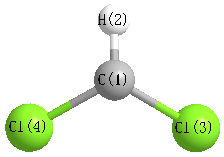Jump to
S1C2
Energy calculated at QCISD/6-311G**
| | hartrees |
|---|
| Energy at 0K | -957.848615 |
| Energy at 298.15K | |
| HF Energy | -957.414786 |
| Nuclear repulsion energy | 125.390791 |
The energy at 298.15K was derived from the energy at 0K
and an integrated heat capacity that used the calculated vibrational frequencies.
Vibrational Frequencies calculated at QCISD/6-311G**
| Mode Number |
Symmetry |
Frequency
(cm-1) |
Scaled Frequency
(cm-1) |
IR Intensities
(km mol-1) |
Raman Act
(Å4/u) |
Dep P |
Dep U |
|---|
| 1 |
A1 |
3296 |
3145 |
0.23 |
|
|
|
| 2 |
A1 |
768 |
733 |
7.98 |
|
|
|
| 3 |
A1 |
322 |
307 |
0.23 |
|
|
|
| 4 |
B1 |
393i |
375i |
53.10 |
|
|
|
| 5 |
B2 |
1299 |
1239 |
55.95 |
|
|
|
| 6 |
B2 |
955 |
911 |
138.26 |
|
|
|
Unscaled Zero Point Vibrational Energy (zpe) 3123.5 cm
-1
Scaled (by 0.9541) Zero Point Vibrational Energy (zpe) 2980.1 cm
-1
See section
III.C.1 List or set vibrational scaling factors
to change the scale factors used here.
See section
III.C.2
Calculate a vibrational scaling factor for a given set of molecules
to determine the least squares best scaling factor.
Geometric Data calculated at QCISD/6-311G**
Point Group is C2v
Cartesians (Å)
| Atom |
x (Å) |
y (Å) |
z (Å) |
|---|
| C1 |
0.000 |
0.000 |
0.672 |
| H2 |
0.000 |
0.000 |
1.750 |
| Cl3 |
0.000 |
1.481 |
-0.170 |
| Cl4 |
0.000 |
-1.481 |
-0.170 |
Atom - Atom Distances (Å)
| |
C1 |
H2 |
Cl3 |
Cl4 |
| C1 | | 1.0781 | 1.7033 | 1.7033 |
H2 | 1.0781 | | 2.4248 | 2.4248 | Cl3 | 1.7033 | 2.4248 | | 2.9610 | Cl4 | 1.7033 | 2.4248 | 2.9610 | |
 More geometry information
More geometry information
Calculated Bond Angles
| atom1 |
atom2 |
atom3 |
angle |
|
atom1 |
atom2 |
atom3 |
angle |
| Cl3 |
C1 |
H2 |
119.637 |
|
Cl3 |
C1 |
Cl4 |
120.727 |
| Cl4 |
C1 |
H2 |
119.637 |
|
Electronic energy levels
Charges, Dipole, Quadrupole and Polarizability
Jump to
S1C1
Energy calculated at QCISD/6-311G**
| | hartrees |
|---|
| Energy at 0K | -957.849554 |
| Energy at 298.15K | -957.850407 |
| HF Energy | -957.416426 |
| Nuclear repulsion energy | 125.249483 |
The energy at 298.15K was derived from the energy at 0K
and an integrated heat capacity that used the calculated vibrational frequencies.
Vibrational Frequencies calculated at QCISD/6-311G**
| Mode Number |
Symmetry |
Frequency
(cm-1) |
Scaled Frequency
(cm-1) |
IR Intensities
(km mol-1) |
Raman Act
(Å4/u) |
Dep P |
Dep U |
|---|
| 1 |
A' |
3260 |
3111 |
2.95 |
|
|
|
| 2 |
A' |
775 |
739 |
12.95 |
|
|
|
| 3 |
A' |
519 |
495 |
25.14 |
|
|
|
| 4 |
A' |
316 |
301 |
0.51 |
|
|
|
| 5 |
A" |
1303 |
1243 |
48.23 |
|
|
|
| 6 |
A" |
926 |
883 |
162.64 |
|
|
|
Unscaled Zero Point Vibrational Energy (zpe) 3549.3 cm
-1
Scaled (by 0.9541) Zero Point Vibrational Energy (zpe) 3386.4 cm
-1
See section
III.C.1 List or set vibrational scaling factors
to change the scale factors used here.
See section
III.C.2
Calculate a vibrational scaling factor for a given set of molecules
to determine the least squares best scaling factor.
Geometric Data calculated at QCISD/6-311G**
Point Group is Cs
Cartesians (Å)
| Atom |
x (Å) |
y (Å) |
z (Å) |
|---|
| C1 |
0.012 |
0.696 |
0.000 |
| H2 |
-0.487 |
1.655 |
0.000 |
| Cl3 |
0.012 |
-0.171 |
1.477 |
| Cl4 |
0.012 |
-0.171 |
-1.477 |
Atom - Atom Distances (Å)
| |
C1 |
H2 |
Cl3 |
Cl4 |
| C1 | | 1.0811 | 1.7126 | 1.7126 |
H2 | 1.0811 | | 2.4011 | 2.4011 | Cl3 | 1.7126 | 2.4011 | | 2.9533 | Cl4 | 1.7126 | 2.4011 | 2.9533 | |
 More geometry information
More geometry information
Calculated Bond Angles
| atom1 |
atom2 |
atom3 |
angle |
|
atom1 |
atom2 |
atom3 |
angle |
| Cl3 |
C1 |
H2 |
116.696 |
|
Cl3 |
C1 |
Cl4 |
119.137 |
| Cl4 |
C1 |
H2 |
116.696 |
|
Electronic energy levels
Charges, Dipole, Quadrupole and Polarizability
